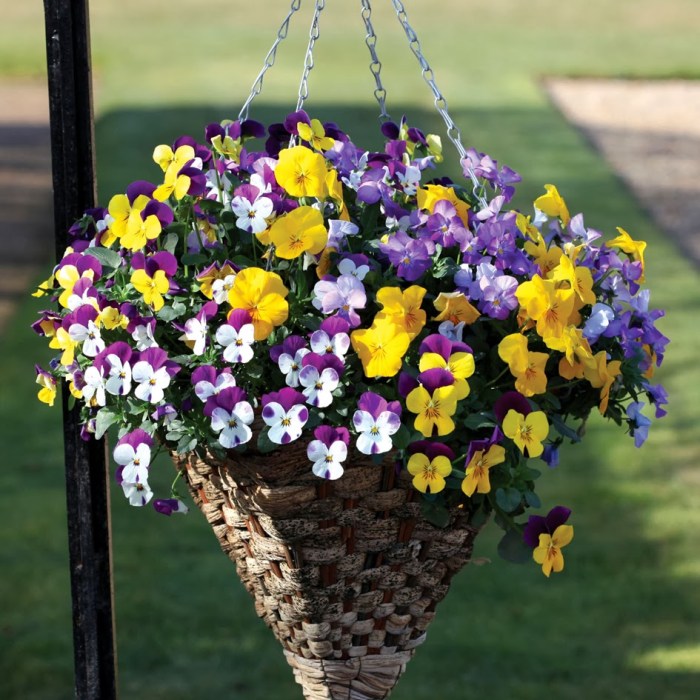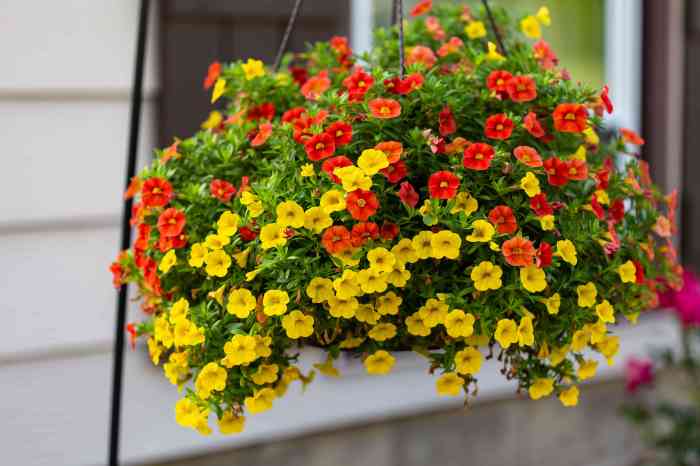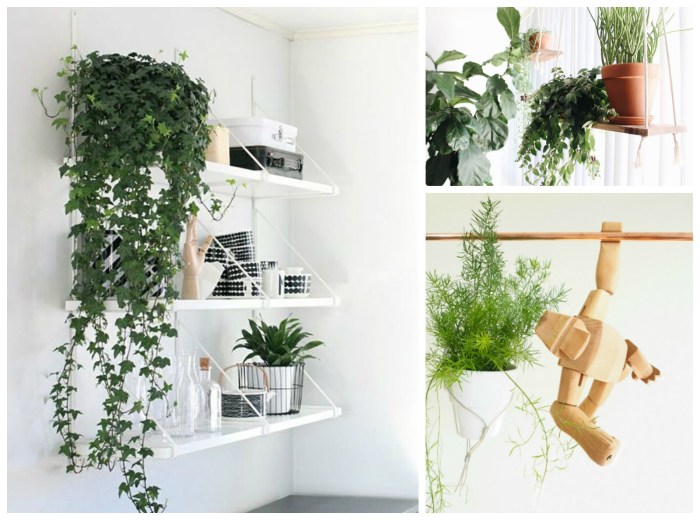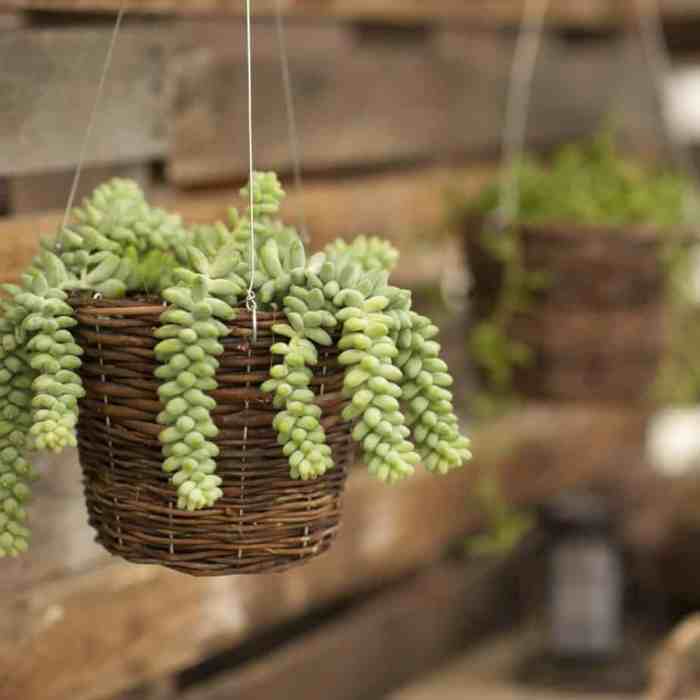Best small hanging plants offer a plethora of benefits, transforming indoor and outdoor spaces with their aesthetic charm, air-purifying qualities, and space-saving design. From tiny ferns to trailing succulents, these plants add a touch of nature to any environment, enhancing small apartments, balconies, and patios.
When selecting small hanging plants, consider light requirements, watering needs, and preferred growing conditions. Proper care includes watering, fertilizing, and pruning, ensuring healthy and vibrant plants. With innovative uses such as vertical gardens, plant walls, and hanging terrariums, these plants bring a unique touch to interior and exterior design.
List of Best Small Hanging Plants

Small hanging plants add a touch of greenery and beauty to any home. They are perfect for small spaces, and they can be used to create a variety of different looks. Here is a list of some of the best small hanging plants:
When choosing a small hanging plant, it is important to consider the amount of light and water that the plant will need. You should also consider the size of the plant and the type of container that you will be using.
Spider Plant (Chlorophytum comosum)
- Spider plants are one of the most popular small hanging plants because they are easy to care for and they can tolerate a wide range of conditions.
- They have long, thin leaves that are variegated with green and white.
- Spider plants produce small white flowers that are followed by small plantlets that can be used to propagate new plants.
Pothos (Epipremnum aureum)
- Pothos is another popular small hanging plant because it is easy to care for and it can tolerate low light conditions.
- It has heart-shaped leaves that are variegated with green, yellow, and white.
- Pothos is a fast-growing plant, and it can quickly fill a hanging basket.
String of Pearls (Senecio rowleyanus)
- String of pearls is a unique small hanging plant that has long, trailing stems that are covered in small, bead-like leaves.
- It is a succulent plant, so it does not need to be watered very often.
- String of pearls is a slow-growing plant, but it can eventually reach a length of several feet.
Burro’s Tail (Sedum morganianum)
- Burro’s tail is a small hanging plant that has long, trailing stems that are covered in plump, succulent leaves.
- The leaves are a beautiful shade of green, and they can turn a reddish color in the sun.
- Burro’s tail is a slow-growing plant, but it can eventually reach a length of several feet.
Trailing Jade (Senecio mandraliscae)
- Trailing jade is a small hanging plant that has long, trailing stems that are covered in small, round leaves.
- The leaves are a beautiful shade of green, and they can turn a reddish color in the sun.
- Trailing jade is a fast-growing plant, and it can quickly fill a hanging basket.
Benefits of Small Hanging Plants: Best Small Hanging Plants
Small hanging plants offer a plethora of advantages, making them an ideal addition to both indoor and outdoor spaces. These miniature gardens bring aesthetic charm, purify the air, and optimize space, transforming any area into a vibrant and inviting haven.
Aesthetic Appeal
Hanging plants add a touch of elegance and tranquility to any room. Their cascading foliage creates a sense of depth and movement, visually expanding the space. They can be used to soften sharp corners, create focal points, or simply bring a touch of nature indoors.
Air-Purifying Qualities
Small hanging plants are natural air purifiers, effectively removing harmful toxins and pollutants from the air. Studies have shown that certain species, such as spider plants and peace lilies, can reduce levels of benzene, formaldehyde, and trichloroethylene, creating a healthier and more comfortable living environment.
Space-Saving Benefits
Hanging plants are a clever solution for space-challenged areas. They can be suspended from ceilings, walls, or shelves, freeing up valuable floor space. This makes them particularly suitable for small apartments, balconies, and patios, where every square foot counts.
Enhancing Specific Areas
Small hanging plants can enhance specific areas in a variety of ways:
- In small apartments, they can add a touch of greenery without overwhelming the space.
- On balconies, they can create a lush and inviting outdoor oasis.
- On patios, they can provide shade and privacy while adding a touch of charm.
Considerations for Choosing Small Hanging Plants

When selecting small hanging plants for different environments, several key factors should be taken into consideration. These include light requirements, watering needs, and preferred growing conditions.
Light Requirements
The amount of light available in a space will determine the types of plants that can be grown successfully. Plants that require bright, indirect light are well-suited for hanging baskets placed near windows. Low-light plants, on the other hand, can tolerate shadier conditions and are ideal for hanging in areas with less natural light.
Watering Needs
The frequency of watering will vary depending on the type of plant and the growing conditions. Plants with thick, fleshy leaves, such as succulents, require less frequent watering than those with thin, delicate leaves. It is important to research the specific watering needs of each plant to avoid overwatering or underwatering.
Preferred Growing Conditions, Best small hanging plants
Some plants prefer warm, humid environments, while others thrive in cooler, drier conditions. It is important to choose plants that are well-suited to the climate and humidity levels of the space where they will be hanging. Additionally, consider the size and shape of the hanging basket when selecting plants, as some plants may require more space to grow and spread.
Care and Maintenance of Small Hanging Plants

Nurturing small hanging plants requires meticulous care and maintenance to ensure their well-being and aesthetic appeal. This involves adhering to specific watering, fertilizing, and pruning practices, as well as addressing common pests and diseases that may affect these plants.
Hanging small plants add a touch of greenery and life to any space. When selecting the best small hanging plants, consider their growth habits, light requirements, and watering needs. For more options on indoor hanging plants, refer to our comprehensive guide on the best houseplants for hanging pots . These recommendations will help you create a lush and vibrant hanging garden that complements your decor and purifies the air.
Watering
Small hanging plants have specific watering needs that vary depending on the species and environmental conditions. It’s crucial to avoid overwatering, which can lead to root rot and other issues. Instead, water thoroughly when the soil feels dry to the touch, allowing excess water to drain freely from the drainage holes.
Fertilizing
Fertilizing is essential for providing small hanging plants with the nutrients they need for healthy growth. Use a balanced liquid fertilizer diluted to half strength and apply it monthly during the growing season. Avoid over-fertilizing, as this can burn the roots.
Small hanging plants bring a touch of greenery and freshness to any indoor space. They’re perfect for adding a pop of color to a room or creating a living wall. If you’re looking for the best plants for indoor wall planters, consider succulents, ferns, and air plants.
These plants are relatively low-maintenance and can tolerate a variety of conditions, making them ideal for indoor environments. You can find more information about the best plants for indoor wall planters by visiting our website.
Pruning
Regular pruning is necessary to maintain the shape and size of small hanging plants and encourage new growth. Use sharp, clean shears to remove dead or damaged leaves, stems, and any unwanted growth. Pruning also helps promote bushier, more compact plants.
Common Pests and Diseases
Small hanging plants can be susceptible to various pests and diseases, including aphids, mealybugs, spider mites, and fungal infections. To prevent infestations, regularly inspect plants for signs of pests or diseases and treat promptly with appropriate pesticides or fungicides.
Creative Uses for Small Hanging Plants

Small hanging plants are not only decorative but also versatile and can be used in various creative ways to enhance both interior and exterior spaces. They add a touch of greenery and freshness while creating unique visual displays.
These versatile plants can be incorporated into vertical gardens, creating living walls that bring nature indoors. They can also be used to create hanging terrariums, providing a miniature ecosystem that is both beautiful and educational.
Living Walls
Small hanging plants are ideal for creating living walls, which are vertical gardens that bring the outdoors in. They can be used to cover entire walls or create smaller, accent displays. Living walls not only add greenery to a space but also improve air quality and reduce noise levels.
Hanging Terrariums
Hanging terrariums are a unique way to display small plants and create a miniature ecosystem. They are typically made of glass or acrylic and can be suspended from the ceiling or placed on a shelf. Terrariums provide a controlled environment for plants, making them ideal for species that require specific humidity or light levels.
Decorative Elements
Small hanging plants can be used as decorative elements in various rooms throughout the house. In living rooms, they can add a touch of greenery to shelves, mantels, or windowsills. In kitchens, they can be hung above the sink or island to provide a splash of color and freshness.
The best small hanging plants can add a touch of greenery and life to any room. But where is the best place to hang them? For maximum impact, consider hanging them in a sunny window or near a bright light source.
If you’re looking for a more subtle effect, try hanging them in a corner or on a wall that doesn’t get a lot of direct light. You can also use hanging plants to create a focal point or to divide a room.
For more ideas on where to hang your indoor plants, visit best place to hang indoor plants .
In bathrooms, they can be placed near the shower or bathtub to create a spa-like atmosphere.
Final Wrap-Up

Best small hanging plants are a versatile and charming addition to any home or garden. Their ability to purify air, save space, and enhance aesthetics makes them a perfect choice for those looking to add a touch of greenery to their surroundings.
FAQ Insights
What are the most popular small hanging plants?
Some of the most popular small hanging plants include ferns, succulents, spider plants, pothos, and air plants.
How do I care for small hanging plants?
Caring for small hanging plants involves watering them regularly, fertilizing them monthly, and pruning them as needed. They should be placed in a location with bright, indirect light.
What are the benefits of hanging plants?
Hanging plants offer several benefits, including improving air quality, adding a touch of greenery to a space, and saving space.